Aha! Roadmaps | Best practices for configuring Aha! to support the Pragmatic Framework
Many companies use the Pragmatic Framework to guide how they build and market products that people want to buy. The framework includes 37 activities — spanning everything from identifying market problems to defining a viable business plan — to ensure the success of new products.
The key to success is aligning teams around the core values of the Pragmatic Framework — namely "outside-in" thinking and delivering problem-oriented solutions. This is where a centralized strategic planning tool that is structured to support Pragmatic principles is essential — so you can bring cross-functional teams together regardless of where they are located.
Aha! Roadmaps provides an effective solution for implementing the Pragmatic Framework. Use it to create a dedicated space to research marketing problems and evaluate potential business ideas, then bring the best opportunities to life. Customizable templates and workflows make Aha! Roadmaps ideal for managing each activity within the framework — empowering everyone to move forward in a synchronized way.
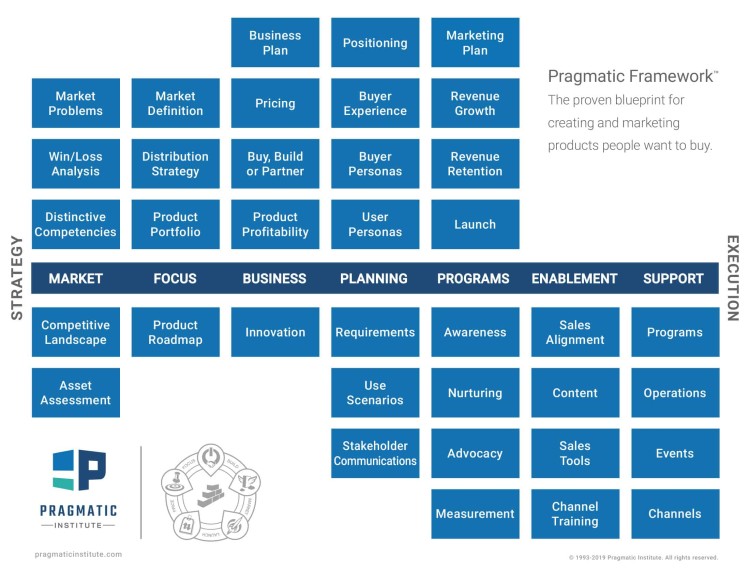
This best practices article explains how to configure Aha! Roadmaps to support the Pragmatic Framework. It focuses on the Market, Focus, and Business steps to help you put the core foundation in place. Of course, you can also use Aha! Roadmaps to implement the Planning, Programs, Enablement, and Support steps of the approach, too. If you have any questions, please contact our Customer Success team. This global team of experts has deep product management expertise, and many of us have experience using the Pragmatic Framework.
Click on any of the links below for recommendations on how to use Aha! Roadmaps for specific steps in the Pragmatic Framework.
Configure your Aha! account
Get started by configuring your workspace hierarchy in Aha! Roadmaps. We recommend creating a dedicated area in your account for evaluating potential business or product ideas. This gives you a centralized place to capture market research, analyze learnings, and determine which ideas to move forward with.
Here is an example of how you can organize your hierarchy to support the Pragmatic Framework.
Company: By default, every new Aha! Roadmaps account starts with a workspace line at the top level of your hierarchy. This is where you define your company-level goals and initiatives to inform the rest of your organization.
New product assessment: Create a workspace line underneath the company level for assessing new product opportunities. This is where you will manage your discovery process for new products and prioritize which ones to implement.
[New product code name]: Create a workspace underneath the New product assessment workspace line for each initial idea that merits further exploration. This is where you will manage all of the activities related to bringing a potential product to market.
The example below shows a workspace hierarchy for a fictitious company called Fredwin Technologies. We have configured the hierarchy to support new product assessments as well as our existing portfolio of products. If we decide to move ahead with a new product idea, we can easily move a workspace to a different location to represent the way our organization is structured. This ensures all information related to the research, business model, and positioning for the new product remains intact as we go from ideation to planning.

Customize your New product assessment workspace line
Your New product assessment workspace line is where you will capture market research and decide whether or not to pursue new product ideas. We recommend using the initiatives record type in Aha! Roadmaps to represent new product ideas. This makes it easy to track the progress of potential opportunities as they move through your discovery and validation process.
Here are a few recommendations to customize your New product assessment workspace line to support the Pragmatic Framework.
Navigation: Customize the navigation in your workspace lane to streamline your view. For example:
Terminology: Change the name of Initiatives in your workspace line settings to New product ideas to match the way you will use this record type. You can also customize the layout and add custom fields as needed.
Custom workflow: Create a custom workflow to mirror the steps in your discovery process. For example, you could define statuses for discovery, validate, prioritize, and position steps in the Pragmatic Framework.
Custom scorecard: Create a custom scorecard to objectively decide which new product ideas to pursue — based on urgency, pervasiveness, and willingness to pay — and visualize their relative importance on a chart.
Build out key templates
The Pragmatic Institute provides a comprehensive set of templates to support key activities in the framework. You can customize templates in Aha! Roadmaps to perfectly match the Pragmatic ones. We recommend building them out in your New product assessment workspace line — so you can automatically make them available to any child workspaces. This enables the team to capture and share information in a consistent way.
Aha! Roadmaps includes many types of strategic planning templates by default — including vision, strategic models, positioning, persona, and competitor templates. You can easily customize these templates to suit your needs or create entirely new ones. You can also create note templates for documenting information such as market research, win/loss analysis, and more.
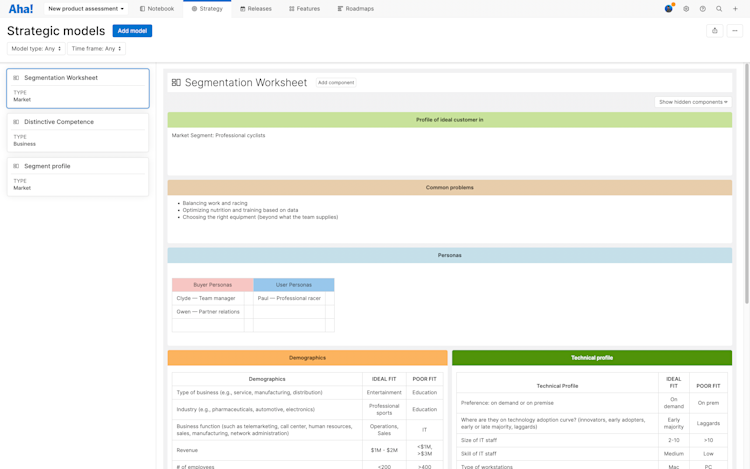
The table below provides a summary of which templates in Aha! Roadmaps to use for key activities in the Market, Focus, and Business steps in the Pragmatic Framework — plus three Planning activities that will support your business plan. If you are a Pragmatic alum, you can access any referenced Pragmatic worksheets in the Pragmatic Community hub.
Pragmatic step | Pragmatic activity | Aha! template |
Market | Market problems | Create note templates to model worksheets such as:
|
Win/loss analysis | Create note templates to model:
Use these example questions to guide your own win/loss interviews
| |
Distinctive competencies | Create a note template to model:
Customize the Aha! strategic model template to visualize your distinctive competencies. | |
Competitive landscape | Create note templates to model worksheets such as:
Use the Aha! Roadmaps competitor section:
| |
Asset assessment | Create a note template to model:
| |
Focus | Market definition | Create a note template to model:
Customize the Segment profile strategic model template. |
Distribution strategy | If you meet with your team to discuss your distribution strategy, use notes and whiteboards to document your conversation. | |
Product portfolio | Customize the initiative chart view to model the Solution Matrix. | |
Product roadmap | Create note templates to model Pragmatic Framework roadmapping worksheets — or use Aha! Roadmaps built-in roadmaps to visualize your strategic plan. | |
Business | Business plan | Create note templates to model worksheets such as:
|
Pricing | Create note templates to model worksheets such as:
| |
Buy, build, or partner | Create a note template to model:
| |
Product profitability | Create a note template to model:
| |
Innovation | Modify the Brainstorming session whiteboard template to document your ideation meetings. | |
Planning | Positioning | Create a note template to model:
Customize the Aha! positioning template to model:
|
Buyer and user personas | Create persona profiles in Aha! Roadmaps to model buyer and user personas |
This article will not cover the Planning step of the Pragmatic Framework — but these activities help support your activities in the Business step. You may choose to start on them early.
Discover market opportunities
Now that you have configured your Aha! account to support the Pragmatic Framework, it is time to get started. Use your New product assessment workspace line to capture ongoing market research, analyze learnings, and validate urgent problems — all in one place.
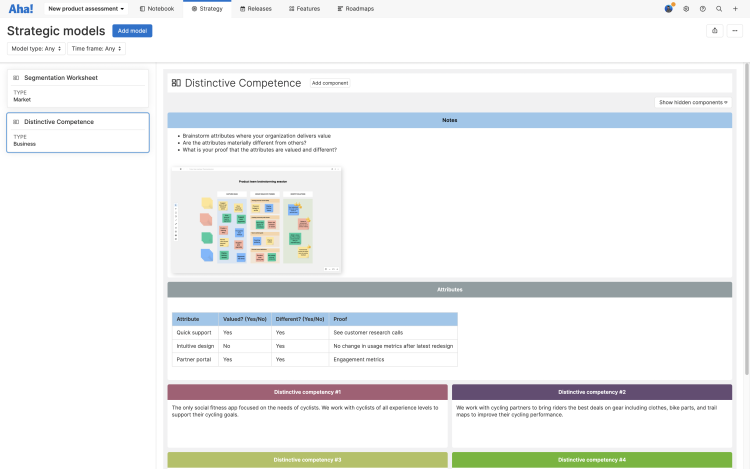
Market problems
The Pragmatic Institute recommends using a variety of primary and secondary research techniques to identify market problems. The focus here is on listening to the market to ensure that new product ideas are vetted using an "outside-in" approach. Use the notes section in your workspace line to document your findings.
Aha! Roadmaps also includes a number of tools to help you gather input from your community. For example, you can create an ideas portal — so customers, partners, and employees can submit new ideas and vote on existing ones. Customers on the Ideas Advanced plan can expand how they collect feedback via online focus groups, polls, and in-app feedback. Analyze feedback trends to identify problems that your product portfolio does not currently address.
Win/loss analysis
Understand why recent evaluators did or did not buy your product(s). This enables you to understand the buying process and any gaps in your current offering. Create a win/loss folder in the notes section of your workspace line — so you can identify themes. Use the customer journey map template to visualize each stage of the buying process. This helps you understand what customers are thinking and feeling as they move from awareness to making a buying decision.
Distinctive competencies
Articulate your organization's unique abilities to deliver value to the market. Use your distinctive competency note template to identify your key attributes as they relate to purpose, reputation, innovation, methods, and expertise (PRIME). Once identified, fill in your custom strategic model. This makes it easy to capture and share your distinctive competencies with your team.
Competitive landscape
Map out your competitive landscape. Create competitor profiles to track direct, indirect, and aspirational competitors. Capture key intelligence about each competitor and use the chart view to compare how you stack up against them. Create a custom competitor threat scorecard to align with how you organize and rate the competition.
Asset assessment
Inventory your company's assets. Use the asset management assessment note template that you created earlier to document physical and non-physical assets such as technical, skills, services, and patents. Capturing this information in Aha! Roadmaps will help you understand what assets you can leverage in the creation of future products to help you build a viable business plan.
Focus on new product ideas
Once you identify a potential product opportunity that you want to vet further, add it as an initiative in your New product assessment workspace line. Initiatives cover large strategic efforts, so they are the perfect Aha! record to compare new product ideas to each other. Use the initiative workflow board to visualize the status of all new product ideas that you are currently assessing.

Next, create a new child workspace under the New product assessment workspace line for each initiative you want to define further. (If you do not yet have a product name in mind, use a code name.) From here, you will define the market, map customer needs with target markets, and analyze the market segments you want to actively pursue.
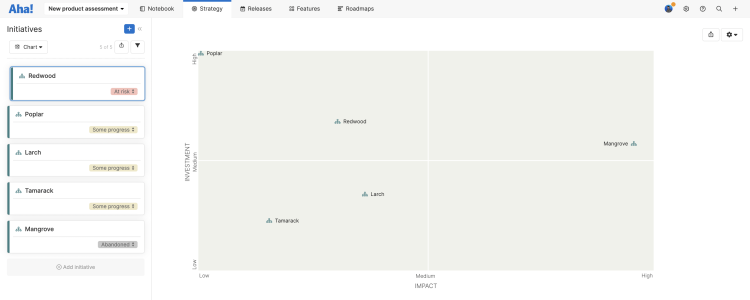
Market definition
Define your target market segments. Use the note template you created earlier to complete the Segmentation Worksheet, so you can document the needs of your target market and prioritize segments you want to actively pursue. Then document your target segments using the Segment profile strategic model template. You can customize this template to add any fields that help you define the segment in the context of your business.
Distribution strategy
Research your market — and remember the Pragmatic Institute's outside-in approach to distribution. Analyze the ways people in your target segments purchase products, then evaluate your own company's ability to implement a distribution strategy that aligns with their preferences. This helps you identify the sales channels most likely to succeed and informs your marketing strategies. Use a strategic model to document your findings — either an existing template or one you customize to capture your chosen distribution strategy fully.
Product portfolio
No product is an island. Think about your prospective new product in the context of other products at your company — and other solutions you might implement. To visualize this, recreate the Pragmatic Framework Solution Matrix in your Aha! Roadmaps account.
Navigate to the initiatives section of your New product assessment.
Click the Change view type dropdown in the upper left corner of the page and open the initiatives Chart view.
Click on the axis titles to rename them as Investment and Impact.
Drag individual initiatives to their appropriate quadrant in the Solution Matrix.
Product roadmap
Align everyone around the vision for your new product. Use the starter roadmap in Aha! Roadmaps to quickly add initiatives, releases, and features needed to bring your new product to market, then share your roadmap with internal stakeholders (as well as discussion options and scenarios).
Roadmaps in your Aha! account are more than just visual aids — when you update the roadmap you also create records in the background. You can assign these records to the appropriate stakeholders and work cross-functionally to implement your plan.
During the Focus step of the Pragmatic Framework, keep your product roadmap high-level and use it to facilitate discussion. As you move into later steps in the Framework, you can create more sophisticated roadmaps such as strategy roadmaps, Gantt charts, and feature roadmaps to visualize your plan's progress.
Define your business plan
Now it is time to make sure you can build a viable business around your new product idea. Document this work in your [New product codename] workspace, so you have a central location to justify the investment by planning how the product could reach and maintain profitability.
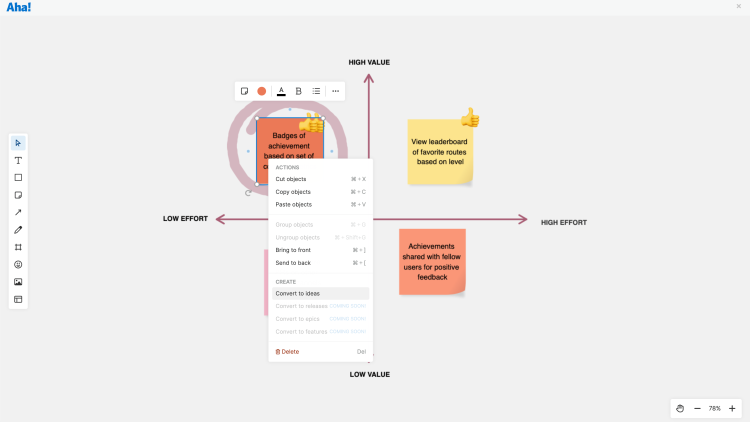
Business plan
Justify your strategic vision. Building on the work you already completed in the Market and Focus steps, complete the Business Plan exercise using a note template. This gives you a place to document your new product’s potential and the quantifiable risks to its future success.
If you want to go deeper, now is a good time to get started on your positioning, buyer personas, and user personas. While these activities are part of the Planning step of the Pragmatic Framework, they can all be highly useful as you document your business plan — and you can always iterate on them as you move into the formal Planning step.
Use the Aha! Roadmaps positioning statement that you customized earlier to document your product positioning.
Create as many Aha! Roadmaps personas as you like to profile buyer and user profiles in your target market segments.
Pricing
Decide on a pricing strategy. Use the note templates you created earlier to complete the Price Implementation Table and the Value Matrix Worksheet. This activity supports your work in your business plan by determining which pricing strategy will best help you achieve your product roadmap and support your corporate goals.
Build, buy, or partner
Identify gaps in your product development and plan how you are going to fill them. Complete the Market/Gap Worksheet in a note from the template you created earlier. Then meet with internal stakeholders to discuss which items you should build yourself, which you can buy, and where you should partner with established offerings to help bring your product to market.
Product profitability
Create a framework to analyze your product's market performance post-launch. Complete the Key Performance Indicators with a note template — so that if you decide to operationalize your new product idea, you will have a structure in place to help you track your product's effect on your company's operations.
Add KPIs as custom fields to a custom record layout. As you prioritize and complete work, you can analyze it in reports in Aha! Roadmaps.
If you have enabled Enterprise+ functionality in your Aha! Roadmaps account, use custom worksheets and advanced equations to calculate financial information — such as the expected revenue from an initiative compared to its cost — right in a record layout.
Innovation
Foster continuous innovation. Use whiteboards for collaborative brainstorming — then convert the best ideas to an Aha! ideas portal for further analysis and prioritization. Build curiosity and experimentation into your team meetings, so that your team is always ready to come up with new solutions to deliver more value to the right customers in your target market segments.
Prioritize new product ideas
You have all the information you need to make a decision about a new product idea — whether the market problem is urgent and pervasive enough that it needs a solution, and whether people are likely to pay your company to solve it if you launch a new product.
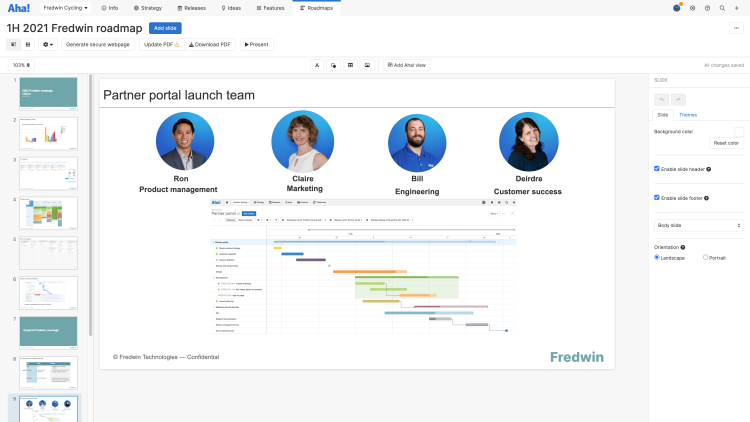
Now use the work you have been doing to compare new product ideas.
In your New product assessment workspace line, open each initiative and update the custom scorecard — or use the initiative chart view to plot the initiatives on the Solution Matrix. Note: You may have customized the terminology in this workspace line to rename initiatives as New product ideas.
Present your findings in an Aha! presentation. This presentation can include any Aha! view or roadmap, so you can include your vision, business plan, high-level strategic roadmap, or any other information.
If you do decide to operationalize your product roadmap, rename your [New product] workspace to your product's name. Then move the workspace out of the New product assessment workspace line and begin the Planning step of the Pragmatic Framework.
The Pragmatic Framework continues beyond the Market, Focus, and Business steps into implementation and support — and you can use your Aha! account to manage the entire product development lifecycle.
Aha! Roadmaps is a complete product management solution. You have used it so far in this article to research marketing problems and evaluate potential business ideas. Use your new product workspace to market, launch, and support your new product.
Aha! Ideas is a comprehensive idea management solution. Capture feedback from your customers (or your internal teams), then use the product value scorecard to prioritize ideas that best fit the needs of your target market segments.
Aha! Whiteboards is the visual space for product innovation. Define user flows, create mockups, and collaborate on roadmaps.
Aha! Knowledge is the AI-powered product information hub. Share all your documents in a central place.
Aha! Develop is the agile tool for healthy software development teams. Connect technical work to the product roadmap, optimize workload, and streamline reporting. Plus, you can use extensions to import work, connect with your ecosystem of tools, and customize the UI.
If you need help configuring your account to support the Pragmatic Framework, please contact us. A member of our Customer Success team will respond to your request quickly and share more about how you can get the most out of your Aha! account as you follow the Framework.
Aha! is a trademark of Aha! Labs Inc. Pragmatic Framework is a registered trademark of The Pragmatic Institute, Inc. All other company and product names may be trademarks of the respective companies with which they are associated.